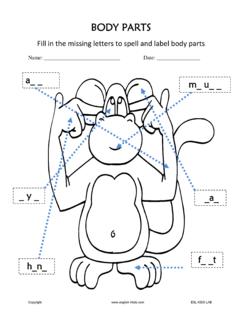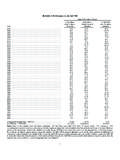Transcription of Financial Aid Award Letters QRG - FastWeb
1 Quick Reference Guide to Evaluating Financial Aid Award Letters Copyright 2011 by FastWeb LLC. All rights reserved. Visit and for information about planning and paying for college Page 1 What is a Financial Aid Award letter ? The Financial aid Award letter provides prospective and current college students with information about the student's college costs and the Financial aid available to help the student pay for these costs. The Award letter may also include details on the college's calculation of the student's demonstrated Financial need. The letter will provide a determination of Financial aid eligibility and, if the student is eligible for Financial aid, a detailed breakdown of the Financial aid package according to the type, amount and source of Financial aid. The Award letter may also include information about the terms and conditions for the Financial aid. Financial aid Award Letters for prospective students typically arrive with or soon after the offer of admission.
2 (For most students this is late March or early April.) Financial aid Award Letters for continuing students may arrive later. Some Financial aid Award Letters will be provided online, through a secure web site. Some colleges require students to accept or reject each source of Financial aid. Others do not. If you reject one form of Financial aid, such as loans or student employment, they will not increase other types of Financial aid to compensate. Compare College Financial Aid Award Letters Based on the Bottom Line Cost To compare Financial aid Award Letters from different colleges, compare them based on the out-of-pocket cost. The out-of-pocket cost is the difference between the total cost of attendance and the total gift aid (grants and scholarships). The cost of attendance includes tuition and required fees, room and board, books, supplies, transportation, personal expenses, dependent care and possibly student health insurance and the cost of a computer.
3 Gift aid does not need to be repaid and includes grants, scholarships, tuition waivers and housing waivers. The out-of-pocket cost is the bottom line cost of college, the amount the family must pay, earn or borrow to cover college costs. The out-of-pocket cost is sometimes called the net price. Since each college awards different amounts of gift aid, the out-of-pocket cost may vary from college to college. This is in contrast with the net cost, which is the difference between the cost of attendance and the need-based Financial aid package. But the Financial aid package includes loans, which have to be repaid (often with interest). This means the actual bottom line cost to the family will be higher than the net cost. The net cost is a measure of cash flow requirements, not the bottom-line cost of college. The net cost will correspond to the expected family contribution (EFC) and will be similar at most colleges. If there are significant differences in net cost, it may be a sign of unusual circumstances that were taken into account at one college but not the others.
4 Thus, families should compare college Financial aid Award Letters based on the out-of-pocket cost and not the net cost. If the difference in out-of-pocket cost is less than $500, the difference is not significant enough to affect the choice of college. But if the difference is greater, especially it is more than $5,000, the family should consider the out-of-pocket cost along with other criteria when choosing a college. Higher out-of-pocket costs lead to a greater debt and work burden, potentially affecting college success and potentially increasing the chances of graduating with excessive debt. The amount of education debt has an impact on further education, career choices and lifestyle after graduation. Tools for Comparing Financial Aid Award Letters FinAid provides two free tools to help you decode and compare Financial aid Award Letters . Simple Award letter Comparison Tool The Simple Award letter Comparison Tool compares the Financial aid packages from three colleges, highlighting any significant differences.
5 It also calculates the net cost and out-of-pocket cost figures, and estimates the lifetime cost of any education loans. Advanced Award letter Comparison Tool The Advanced Award letter Comparison Tool is like the Simple Award letter Comparison Tool, but includes non- Financial criteria in addition to Financial criteria for comparing colleges. The Financial and non- Financial differences are displayed visually in a matrix format. Quick Reference Guide to Evaluating Financial Aid Award Letters Copyright 2011 by FastWeb LLC. All rights reserved. Visit and for information about planning and paying for college Page 2 Problems and Pitfalls with Financial Aid Award Letters No standard for Financial aid Award Letters . There is no standard format for Financial aid Award Letters , making them difficult to interpret and to compare and contrast. Actual costs may be higher than the Expected Family Contribution (EFC).
6 The EFC is not the price you pay. Financial aid packages usually include loans, which have to be repaid, and there may also be unmet need. Some colleges use two different EFCs, one for federal and state aid and another for the college s own funds. Often the price you pay is much higher than the expected family contribution. On the other hand, the amount you pay will probably be lower than the overall cost of attendance. Inconsistent cost of attendance information. Colleges may use different definitions of the cost of attendance. Some colleges don't even include the cost of attendance on the Award letter . Others report just direct costs, which are usually billed by the college, while some report both direct and indirect costs. You can find detailed cost information in the college s catalog or on its web site. Make sure you have current figures for each of the major costs, including tuition and required fees, room and board, textbooks, supplies, travel and transportation, personal expenses, a computer and, if relevant, student health insurance and dependent care ( , childcare or eldercare).
7 Cost allowances may be underestimates and unrealistic. There may be significant differences in the various cost allowances, such as textbooks, travel and transportation, personal expenses and off-campus housing. Some colleges will underestimate these figures to make their costs look less expensive, so make sure the costs are reasonable. You may wish to use the same estimate of textbook costs for all colleges, say $1,000 to $1,200 a year, to ensure that the costs are comparable. Transportation costs may vary based on distance of the college from the student s home, number of trips home per year and whether you reside on campus or commute. Make sure the transportation costs are reasonable. If you will be commuting, the transportation figures should be based on the round-trip distance from home to school, the IRS mileage rate, the number of days on campus and the cost of parking on campus. If you will be living on campus, assume the cost of four round-trip tickets home per year, one for fall break, one for winter break, one for spring break and one for summer break.
8 Discretionary costs are under your control. Some of the indirect costs are discretionary. You can control how much you spend on housing or textbooks. Living off campus with a roommate can reduce your housing costs. Buying only required textbooks, buying textbooks online, buying used textbooks (or older editions or re-imported international editions), renting textbooks, buying textbooks through a co-op, buying ebooks or reselling textbooks to the bookstore at the end of the semester can save you as much as half the cost of the textbooks. You can also borrow textbooks from the college library (or the preview copies from the faculty) or share textbooks with your roommate. Packaging of non-need-based loans. Some colleges include non-need-based loans such as the unsubsidized Stafford and PLUS loans on the Financial aid Award letter in order to increase awareness of lower-cost federal loans. Families are eligible for these loans at every college, regardless of Financial need.
9 You are under no obligation to accept the loans and can request a lower loan amount. (Refusing these loans, however, will not increase your grants.) Try to avoid borrowing the maximum allowable amounts if you don t need to, as every dollar you borrow will cost you about two dollars by the time you ve repaid the debt. Live like a student while you are in school so you don t have to live like a student after you graduate. Gapping. Some colleges do not provide enough Financial aid to meet the full demonstrated Financial need. This leaves the student with unmet need, also referred to as a gap. This is more likely at colleges with limited Financial aid resources. Some colleges may try to mask the existence of a gap by including loans in the Financial aid package, by increasing work expectations or by underestimating costs. Online Sources of Textbooks Barnes & Noble ( ) Google ( ) Cost of Attendance Direct Costs (Required) o Tuition and Required Fees o Room and Board o Textbooks and Supplies Indirect Costs (Discretionary) o Travel and Transportation o Personal Expenses o Computer o Student Health Insurance o Dependent Care Quick Reference Guide to Evaluating Financial Aid Award Letters Copyright 2011 by FastWeb LLC.
10 All rights reserved. Visit and for information about planning and paying for college Page 3 It may be difficult to determine the type of each Award . Financial aid Award Letters sometimes use cryptic acronyms or abbreviations for awards or fail to identify the type of an Award , making it difficult to distinguish loans (which have to be repaid) and student employment from gift aid such as grants and scholarships (which do not have to be repaid). Most Financial aid Award Letters do not mention interest rates, fees, monthly payments and total payments next to the loan amounts. A loan might be identified as a LN or just by name. Typical loans include the Federal Perkins Loan, Federal Subsidized Stafford Loan, Federal Unsubsidized Stafford Loan, Federal PLUS Loan and private or alternative student loans. The Federal TEACH Grant is actually a forgivable loan. Federal Work-Study and College Work-Study are forms of student employment.










